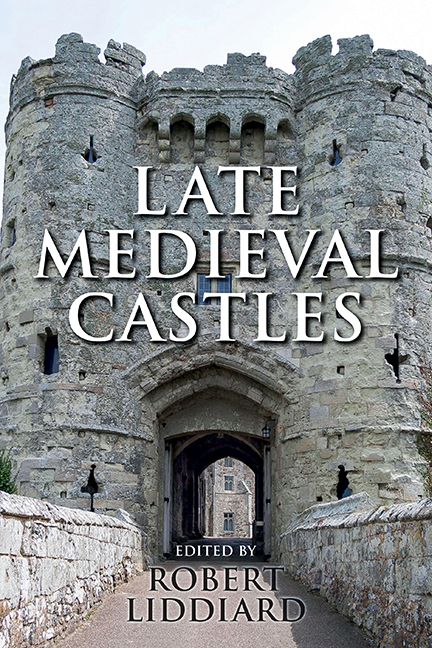Book contents
- Frontmatter
- Contents
- List of Illustrations
- Acknowledgements
- Editor's Preface
- List of Abbreviations
- A Note on the Text
- Introduction
- 1 Fourteenth-Century Castles in Context: Apotheosis or Decline?
- 2 Architects, Advisors and Design at Edward I's Castles in Wales
- 3 The Courtyard and the Tower: Contexts and Symbols in the Development of Late Medieval Great Houses
- 4 Castle Planning in the Fourteenth Century
- 5 Meaningful Constructions: Spatial and Functional Analysis of Medieval Buildings
- 6 Mota, Aula et Turris: The Manor-Houses of the Anglo-Scottish Border
- 7 Lulworth Castle, Dorset
- 8 A Scottish Problem with Castles
- 9 Structural Symbolism in Medieval Castle Architecture
- 10 Specimens of Freedom to Crenellate by Licence
- 11 Some Analysis of the Castle of Bodiam, East Sussex
- 12 English Castles in the Reign Of Edward II
- 13 Castles of Ward and the Changing Pattern of Border Conflict in Ireland
- 14 The Donjon Of Knaresborough: The Castle As Theatre
- 15 The Architecture of Arthurian Enthusiasm: Castle Symbolism in the Reigns of Edward I and his Successors
- 16 Medieval Ornamental Landscapes
- 17 Otherworld Castles in Middle English Arthurian Romance
- Guide to Further Reading
- Index
16 - Medieval Ornamental Landscapes
Published online by Cambridge University Press: 29 April 2017
- Frontmatter
- Contents
- List of Illustrations
- Acknowledgements
- Editor's Preface
- List of Abbreviations
- A Note on the Text
- Introduction
- 1 Fourteenth-Century Castles in Context: Apotheosis or Decline?
- 2 Architects, Advisors and Design at Edward I's Castles in Wales
- 3 The Courtyard and the Tower: Contexts and Symbols in the Development of Late Medieval Great Houses
- 4 Castle Planning in the Fourteenth Century
- 5 Meaningful Constructions: Spatial and Functional Analysis of Medieval Buildings
- 6 Mota, Aula et Turris: The Manor-Houses of the Anglo-Scottish Border
- 7 Lulworth Castle, Dorset
- 8 A Scottish Problem with Castles
- 9 Structural Symbolism in Medieval Castle Architecture
- 10 Specimens of Freedom to Crenellate by Licence
- 11 Some Analysis of the Castle of Bodiam, East Sussex
- 12 English Castles in the Reign Of Edward II
- 13 Castles of Ward and the Changing Pattern of Border Conflict in Ireland
- 14 The Donjon Of Knaresborough: The Castle As Theatre
- 15 The Architecture of Arthurian Enthusiasm: Castle Symbolism in the Reigns of Edward I and his Successors
- 16 Medieval Ornamental Landscapes
- 17 Otherworld Castles in Middle English Arthurian Romance
- Guide to Further Reading
- Index
Summary
In recent years archaeologists in Britain have found many examples of what have been called ‘ornamental landscapes’ of medieval date. These landscapes comprise the archaeological remains of former lakes, ponds, moats, causeways, gardens, deer parks and other features, and are associated with castles and other high-status buildings. They seem to have been intended to enhance the setting of these buildings as well as to provide places of entertainment and recreation. This paper recounts the discovery of these landscapes and describes their archaeological components and some of their related buildings. It analyses the evidence from documents and illustrations for their existence and appearance. It discusses their creators, the motives behind their creation and their influence on the development of later ornamental landscapes. The paper concludes with an examination of the problems of defining such landscapes.
Analytical field archaeology, that is the discovery, recording and interpretation of upstanding archaeological remains, has made many contributions to landscape history. It is thus appropriate that in the first issue of a new journal concerned with this subject there should be a paper devoted to some of the results of this method of research. Until relatively recently, analytical field archaeology was almost entirely concerned with utilitarian sites and landscapes of all periods. But in the 1970s and 1980s field archaeologists began to find and record the remains of former pleasure gardens, mainly of sixteenth-century and later date. One result of this was the realisation that abandoned gardens are one of the commonest type of archaeological sites in Britain (Taylor 1983, 1997, 1998a). Later fieldwork led to the discovery of medieval gardens, which turned out to be much more varied in form than garden historians had hitherto believed (Brown and Taylor 1991; Everson et al. 1991, 54; Blood and Taylor 1992; Rose 1994). The wider understanding of these former gardens was only achieved by co-operation with workers in other disciplines. Similarly, this paper, although based on the results of analytical field archaeology, could not have been written without the work of other scholars. During the 1980s the writer and two of his colleagues recorded the medieval and later archaeological sites in part of Lincolnshire for the Royal Commission on the Historical Monuments of England.
- Type
- Chapter
- Information
- Late Medieval Castles , pp. 375 - 392Publisher: Boydell & BrewerPrint publication year: 2016

